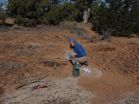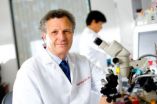WSU scientists find new way for antibiotic resistance to spread
Selection of resistant microbes takes place outside animal
2012-11-16
(Press-News.org) PULLMAN, Wash.—Washington State University researchers have found an unlikely recipe for antibiotic resistant bacteria: Mix cow dung and soil, and add urine infused with metabolized antibiotic. The urine will kill off normal E. coli in the dung-soil mixture. But antibiotic-resistant E. coli will survive in the soil to recolonize in a cow's gut through pasture, forage or bedding.
"I was surprised at how well this works, but it was not a surprise that it could be happening," says Doug Call, a molecular epidemiologist in WSU's Paul G. Allen School for Global Animal Health. Call led the research with an immunology and infectious disease Ph.D. student, Murugan Subbiah, now a post-doctoral researcher at Texas A & M. Their study appears in a recent issue of the online journal PLOS ONE.
While antibiotics have dramatically reduced infections in the past 70 years, their widespread and often indiscriminate use has led to the natural selection of drug-resistant microbes. People infected with the organisms have a harder time getting well, with longer hospital stays and a greater likelihood of death.
Animals are a major source of resistant bugs, receiving the bulk of antibiotics sold in the U.S.
The scientists focused on the antibiotic ceftiofur, a cephalosporin believed to be helping drive the proliferation of resistance in bacteria like Salmonella and E. coli. Ceftiofur has little impact on gut bacteria, says Call.
"Given that about 70 percent of the drug is excreted in the urine, this was about the only pathway through which it could exert such a large effect on bacterial populations that can reside in both the gut and the environment," he says.
Until now, conventional thinking held that antibiotic resistance is developed inside the animal, Call says.
"If our work turns out to be broadly applicable, it means that selection for resistance to important drugs like ceftiofur occurs mostly outside of the animals," he says. "This in turn means that it may be possible to develop engineered solutions to interrupt this process. In doing so we would limit the likelihood that antibiotic resistant bacteria will get back to the animals and thereby have a new approach to preserve the utility of these important drugs."
One possible solution would be to find a way to isolate and dispose of residual antibiotic after it is excreted from an animal but before it interacts with soil bacteria.
The WSU experiments were performed in labs using materials from dairy calves. Researchers must now see if the same phenomenon takes place in actual food-animal production systems.
INFORMATION:
The paper, "Urine from Treated Cattle Drives Selection for Cephalosporin Resistant Escherichia coli in Soil," can be seen at http://www.plosone.org/article/info%3Adoi%2F10.1371%2Fjournal.pone.0048919.
END
ELSE PRESS RELEASES FROM THIS DATE:
2012-11-16
What can high school and college-age video game enthusiasts teach young surgeons-in-training?
According to a new study from researchers at the University of Texas Medical Branch at Galveston (UTMB) – a world leader in minimally invasive and robotic surgery – the superior hand-eye coordination and hand skills gained from hours of repetitive joystick maneuvers mimic the abilities needed to perform today's most technologically-advanced robotic surgeries.
To offer insight on how best to train future surgeons, the study placed high school and college students head to head ...
2012-11-16
Some arid lands in the American West degraded by military exercises that date back to General George Patton's Word War II maneuvers in the Mojave Desert should get a boost from an innovative research project led by the University of Colorado Boulder.
Headed up by CU-Boulder Assistant Professor Nichole Barger, the research team is focused on developing methods to restore biological soil crusts -- microbial communities primarily concentrated on soil surfaces critical to decreasing erosion and increasing water retention and soil fertility. Such biological soil crusts, known ...
2012-11-16
By combining the power of the NASA/ESA Hubble Space Telescope, NASA's Spitzer Space Telescope and one of nature's zoom lenses, astronomers have found what is probably the most distant galaxy yet seen in the Universe. The object offers a peek back into a time when the Universe was only 3 percent of its present age of 13.7 billion years.
We see the newly discovered galaxy, named MACS0647-JD, as it was 420 million years after the Big Bang. Its light has travelled for 13.3 billion years to reach Earth, which corresponds to a redshift of approximately 11 [1].
This is the ...
2012-11-16
An efficient, high-volume technique for testing potential drug treatments for Alzheimer's disease uncovered an organic compound that restored motor function and longevity to fruit flies with the disease, according to new research that could help put the search for an effective Alzheimer's drug on a faster track.
Princeton University researchers report in the Journal of Biological Chemistry that they discovered an organic compound that prevented the formation of protein clumps, or aggregates, found on human brain cells afflicted by Alzheimer's disease. The researchers ...
2012-11-16
LA JOLLA, Calif., November 15, 2012 – Researchers and patients look forward to the day when stem cells might be used to replace dying brain cells in Alzheimer's disease and other neurodegenerative conditions. Scientists are currently able to make neurons and other brain cells from stem cells, but getting these neurons to properly function when transplanted to the host has proven to be more difficult. Now, researchers at Sanford-Burnham Medical Research Institute (Sanford-Burnham) have found a way to stimulate stem cell-derived neurons to direct cognitive function after ...
2012-11-16
(Phoenix, AZ Nov. 15, 2012) -- Vision researchers at Barrow Neurological Institute have made a groundbreaking discovery into the optimization of light sources to human vision. By tuning lighting devices to work more efficiently with the human brain the researchers believe billions of dollars in energy costs could be saved.
The research was conducted by Stephen Macknik, PhD, of Barrow's Laboratory of Behavioral Neurophysiology, and Susana Martinez-Conde, PhD, of Barrow's Laboratory of Visual Neuroscience. The study is published Proceedings of the National Academy ...
2012-11-16
Untreated depression is one of the leading causes of teen suicide, and signs of depression can also be a warning that a teen is contemplating suicide. In an article published this week in the quarterly journal, The Prevention Researcher, University of Cincinnati researchers are describing how positive connections can help offset these tragedies.
In the current issue, titled, "Teen Depression," UC researchers Keith King, a professor of health promotion, and Rebecca Vidourek, an assistant professor of health promotion, report that depression and suicide are "intricately ...
2012-11-16
CAMBRIDGE, MA -- Gels that can be injected into the body, carrying drugs or cells that regenerate damaged tissue, hold promise for treating many types of disease, including cancer. However, these injectable gels don't always maintain their solid structure once inside the body.
MIT chemical engineers have now designed an injectable gel that responds to the body's high temperature by forming a reinforcing network that makes the gel much more durable, allowing it to function over a longer period of time.
The research team, led by Bradley Olsen, an assistant professor of ...
2012-11-16
BETHESDA, Md. (Nov. 15, 2012)—Chronic wounds such as foot ulcers are a common problem for diabetics and are the cause of more than 80 percent of the lower leg amputations in these patients. There is currently no effective way to improve healing of these types of wounds, but new research offers hope.
French researchers found that diabetic rats on a high protein diet with arginine and proline—specific molecules found in protein—showed better wound healing over rats fed either standard or high protein food without arginine and proline supplementation.
The article is entitled ...
2012-11-16
A Simon Fraser University archaeologist and his colleagues at the University of Queensland in Australia have significantly narrowed down the time frame during which the last major chapter in human colonization, the Polynesian triangle, occurred.
SFU professor David Burley, Marshall Weisler and Jian-Xin Zhao argue the first boats arrived between 880 and 896 BC. The 16-year window is far smaller than the previous radiocarbon-dated estimate of 178 years between 2,789 and 2,947 years ago.
Burley, the lead author, and his colleagues have recently had their claims published ...
LAST 30 PRESS RELEASES:
[Press-News.org] WSU scientists find new way for antibiotic resistance to spread
Selection of resistant microbes takes place outside animal



